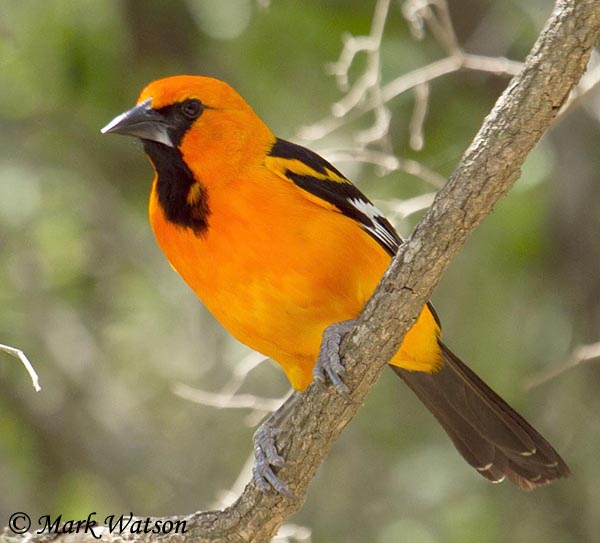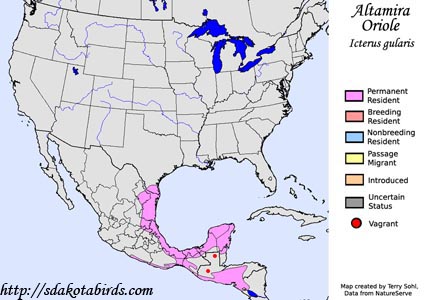| Length: 10 inches | Wingspan: 14 inches | Seasonality: Non-resident in South Dakota |
| ID Keys: Largest oriole species. Black lores, black chin and throat, orange body with dark across mid-back, black wings with one white and one orange wingbar | ||
 The
Altamira Oriole is the largest oriole in North America. They are
mostly found in Mexico and parts of Central America. They were unknown
in the United States until a bird was spotted in southern Texas in 1939.
Since then, they have become increasingly common, and are breeding residents
along the Rio Grande River along the Texas and Mexico border.
The
Altamira Oriole is the largest oriole in North America. They are
mostly found in Mexico and parts of Central America. They were unknown
in the United States until a bird was spotted in southern Texas in 1939.
Since then, they have become increasingly common, and are breeding residents
along the Rio Grande River along the Texas and Mexico border.
Habitat: In the United States, Altamira Orioles are usually found in forested areas along the Rio Grande river in southern Texas. In the more tropical parts of their range, they can be found in a variety of semi-open forested habitat and forest edges, but tend to avoid dense unbroken forest areas.
Diet: Feeds on insects and berries, and will also take fruits and berries.
Behavior: Moves slowly through the foliage of trees and in the forest undergrowth, searching for insects.
Nesting: The nest of an Altamira Oriole is a very long pouch, built of grasses, moss, weed stems, strips of bark, and other material, hanging down from the end of a tree branch. The female lays between 4 and 6 eggs. Once the eggs hatch, both parents help feed the young.
Interactive eBird Map: Click to access an interactive eBird map of Altamira Oriole sightings
Song: Song is a series of clear whistles, delivered slowly and deliberately with pauses in between notes.
Migration: Considered a permanent resident throughout their normal range.
Feeders: Will attend hummingbird feeders for sugar water, and will also sometimes come for offered fruits and jelly.
Similar Species: In range, most likely to be confused with Hooded Oriole, Baltimore Oriole, Bullock's Oriole
Conservation Status: Populations may be increasing, and the geographic range may be expanding. The IUCN lists the Altamira Oriole as a species of "Least Concern".
Further Information: 1) WhatBird - Altamira Oriole
2) Audubon Field Guide - Altamira Oriole
3) Wikipedia - Altamira Oriole
Photo Information: Photo by Mark Watson - March 12th, 2011 - Bensen State Park near McAllen, Texas - Photo licensed under Creative Commons Attribution NonCommerical NoDerivs 2.0 Generic License.
| Click below for a higher-resolution map |
 |
| South Dakota Status: Non-resident in South Dakota |
Additional Altamira Oriole Photos (coming soon!!)
